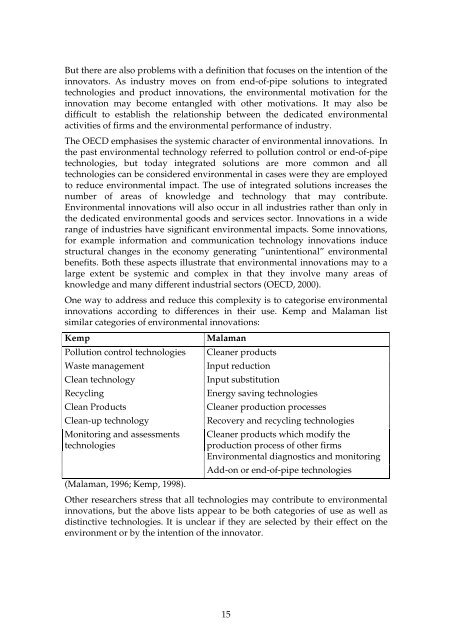Drivers of environmental innovation - Vinnova
Drivers of environmental innovation - Vinnova
Drivers of environmental innovation - Vinnova
You also want an ePaper? Increase the reach of your titles
YUMPU automatically turns print PDFs into web optimized ePapers that Google loves.
But there are also problems with a definition that focuses on the intention <strong>of</strong> the<br />
innovators. As industry moves on from end-<strong>of</strong>-pipe solutions to integrated<br />
technologies and product <strong>innovation</strong>s, the <strong>environmental</strong> motivation for the<br />
<strong>innovation</strong> may become entangled with other motivations. It may also be<br />
difficult to establish the relationship between the dedicated <strong>environmental</strong><br />
activities <strong>of</strong> firms and the <strong>environmental</strong> performance <strong>of</strong> industry.<br />
The OECD emphasises the systemic character <strong>of</strong> <strong>environmental</strong> <strong>innovation</strong>s. In<br />
the past <strong>environmental</strong> technology referred to pollution control or end-<strong>of</strong>-pipe<br />
technologies, but today integrated solutions are more common and all<br />
technologies can be considered <strong>environmental</strong> in cases were they are employed<br />
to reduce <strong>environmental</strong> impact. The use <strong>of</strong> integrated solutions increases the<br />
number <strong>of</strong> areas <strong>of</strong> knowledge and technology that may contribute.<br />
Environmental <strong>innovation</strong>s will also occur in all industries rather than only in<br />
the dedicated <strong>environmental</strong> goods and services sector. Innovations in a wide<br />
range <strong>of</strong> industries have significant <strong>environmental</strong> impacts. Some <strong>innovation</strong>s,<br />
for example information and communication technology <strong>innovation</strong>s induce<br />
structural changes in the economy generating ”unintentional” <strong>environmental</strong><br />
benefits. Both these aspects illustrate that <strong>environmental</strong> <strong>innovation</strong>s may to a<br />
large extent be systemic and complex in that they involve many areas <strong>of</strong><br />
knowledge and many different industrial sectors (OECD, 2000).<br />
One way to address and reduce this complexity is to categorise <strong>environmental</strong><br />
<strong>innovation</strong>s according to differences in their use. Kemp and Malaman list<br />
similar categories <strong>of</strong> <strong>environmental</strong> <strong>innovation</strong>s:<br />
Kemp<br />
Pollution control technologies<br />
Waste management<br />
Clean technology<br />
Recycling<br />
Clean Products<br />
Clean-up technology<br />
Monitoring and assessments<br />
technologies<br />
(Malaman, 1996; Kemp, 1998).<br />
Malaman<br />
Cleaner products<br />
Input reduction<br />
Input substitution<br />
Energy saving technologies<br />
Cleaner production processes<br />
Recovery and recycling technologies<br />
Cleaner products which modify the<br />
production process <strong>of</strong> other firms<br />
Environmental diagnostics and monitoring<br />
Add-on or end-<strong>of</strong>-pipe technologies<br />
Other researchers stress that all technologies may contribute to <strong>environmental</strong><br />
<strong>innovation</strong>s, but the above lists appear to be both categories <strong>of</strong> use as well as<br />
distinctive technologies. It is unclear if they are selected by their effect on the<br />
environment or by the intention <strong>of</strong> the innovator.<br />
15

















